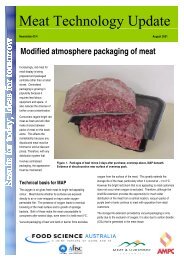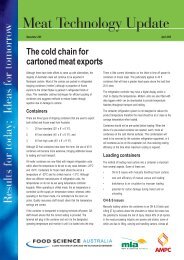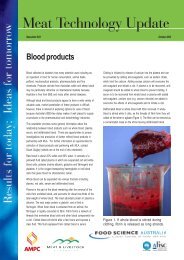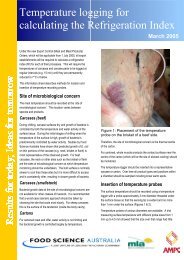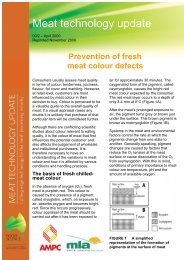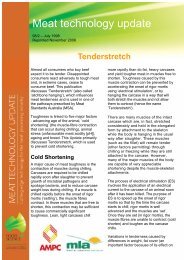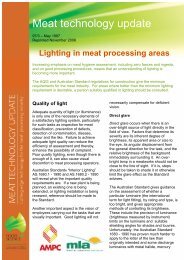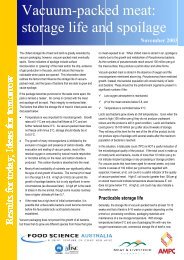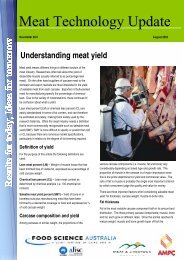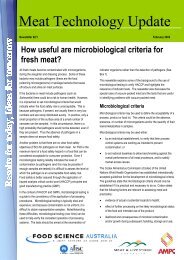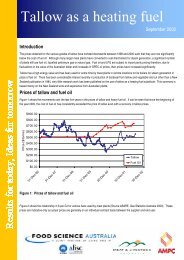Organic Acids - Meat Industry Services
Organic Acids - Meat Industry Services
Organic Acids - Meat Industry Services
Create successful ePaper yourself
Turn your PDF publications into a flip-book with our unique Google optimized e-Paper software.
<strong>Meat</strong> <strong>Industry</strong> <strong>Services</strong>Supported by:Hot carcass surfaces treated with organic acids often display somediscoloration of tissue or fat surfaces. However, as with hot waterpasteurisation, this often disappears or becomes less evident after chilling.There may be issues with meat surface discolouration, and operators mayexperience skin/eye irritation when acetic acid is used. <strong>Organic</strong> acids (aceticand lactic acid) have been evaluated as a method of sanitising beef carcassesduring spray chilling. The studies found a significant (up to 3 log) reduction intotal aerobic count and pathogen populations (Dickson 1991; Hamby et al.1987).In the literature, there is also mention of the possibility for the use of organicacids to alter the microbial ecology of meat plant environments and potentiallythat of the beef, and should be considered when selecting food safetytechnologies for meat (Acuff 2005). There are also concerns associated withusing organic acids in that they may select for the presence of acid-resistantbacteria that may accelerate rates of product spoilage, increase undesirableeffects on product appearance, and speed equipment corrosion (Gill 1998).Approximate costs for organic acid spray in beef/pork processing plants(A$, adapted from Reynolds 2005)<strong>Organic</strong>acidLacticAcid(88%foodgrade)2%solution =23 ml + 1litres H 2 OListprice(200litres)$1063.00Costperunit(ml)Costper litreofsolutionCost percarcass*0.5¢ 9¢ 7¢ (pig)14¢(beef)* eight litres of 2% lactic acid will treat approximately 10 pigs or 5 beefcarcasses.<strong>Organic</strong> <strong>Acids</strong>Updated June 2006 Page 3 of 5
<strong>Meat</strong> <strong>Industry</strong> <strong>Services</strong>Supported by:Proponent/Supplier InformationWash cabinets may be installed by a number of companies such as APV,FPE or CHAD:APV Australia (Invensys Companies)National Sales & Service CentrePh. 1-800-100-278Email: tony.harris@invensys.comWebsite: www.apv.com.auFood Processing Equipment (FPE).Contact: Shaun FrederickAddress: 878 Main North Road Pooraka South Australia 5095Ph: 1800 882 549Fax: 08 8262 5700Email: shaunf@fpe.net.auWebsite: http://www.fpe.net.au/home.htmlCHAD CompanyUnited StatesContact: Rosey HohendorfPh. (800) 444-8360Fax: (913) 764-0779E-mail: rosey@chadcompany.comWebsite: www.chadcompany.comThere are many food acid-grade suppliers in Australia. One larger company isSwift Australia.Swift Australia (Head Office)1 st Floor, 372 Wellington Rd,Mulgrave, VIC 3170.Ph: 03 8544 3100 Fax. 03 8544 3299Website: http://www.swiftco.com.au<strong>Organic</strong> <strong>Acids</strong>Updated June 2006 Page 4 of 5
<strong>Meat</strong> <strong>Industry</strong> <strong>Services</strong>Supported by:ReferencesAcuff, G. R. (2005) Chemical decontamination strategies for meat. In:Improving the Safety of Fresh <strong>Meat</strong> (Ed: Sofos, J. N.) Woodhead PublishingLimited. CRC Press, New York. Pp 351-363.Dickson, J. S. (1991) Control of Salmonella Typhimurium, Listeriamonocytogenes, and Escherichia coli O157:H7 on beef in a model spraychilling system. Journal of Food Science 56: 191-193.Dubal, Z. B., Paturkar, A. M., Waskar, V. S., Zende, R. J., Latha, C., Rawool,D. B. Kadam, M. M. (2004) Effect of food grade organic acids on inoculated S.aureus, L. monocytogenes, E. coli and S. Typhimurium in sheep/goat meatstored at refrigeration temperature. <strong>Meat</strong> Science 66: 817-821.FDA (2003) Code of Federal Regulations Title 21, Government PrintingOffice, USAGill, C. O. (1998) Microbiological contamination of meat during slaughter andbutchering of cattle, sheep and pigs. In: The Microbiology of <strong>Meat</strong> and Poultry(Ed: Davies, A. and Board, R.) Blackie Academic & Professional, London.Pp118-157.Gill, C.O., Landers, C. (2003) Microbiological effects of carcassdecontaminating treatments at four beef packing plants. <strong>Meat</strong> Science 65:1005-1011Hamby, P. L., Savell, J. W., Acuff, G. R., Vanderzant, C. Cross, H. R. (1987)Spray-chilling and carcass decontamination systems using lactic and aceticacid. <strong>Meat</strong> Science 21: 1-14.Podolak, R. K., Zayas, J. F., Kastner, C. L., Fung, D. Y. C. (1996) Reductionof bacterial populations on vacuum-packaged ground beef patties with fumaricand lactic acids. Journal of Food Protection. 59: 1037-1040.Ramirez, A. J., Acuff, G. R., Lucia, L. M., Savell, J. W. (2001) Lactic acid andtrisodium phosphate treatment of lamb breast to reduce bacterialcontamination. Journal of Food Protection 64: 1439-1441.Ransom, J. R., Belk, K. E., Sofos, J. N., Stopforth, J. D. Scanga, J. A., Smith,G. C. (2003) Comparison of intervention technologies for reducingEscherichia coli O157:H7 on beef cuts and trimmings. Food ProtectionTrends 23: 24-34.USDA/FSIS (2004), Safe and suitable ingredients used in the production ofmeat and poultry products. FSIS Directive 7120.1 Amendment 6, USDA-FSIS.<strong>Organic</strong> <strong>Acids</strong>Updated June 2006 Page 5 of 5



